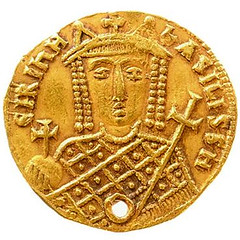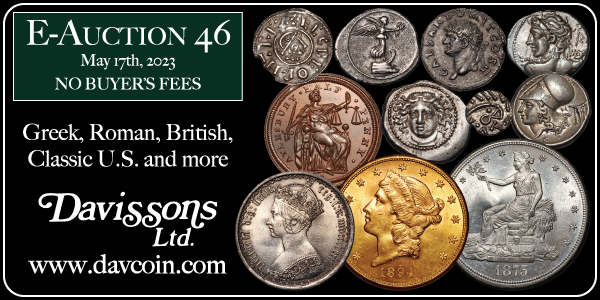
PREV ARTICLE
NEXT ARTICLE
FULL ISSUE
PREV FULL ISSUE
PRINCETON'S BYZANTINE COIN COLLECTIONThe Princeton Alumni Weekly published an article on the University's Byzantine coin collection. -Editor
A few years earlier, a similar image of Irene appeared on a gold coin whose other face showed her son and co-regent Constantine VI. But in 797, Irene had her son seized, blinded, and imprisoned in order to become the empire's sole ruler, said Teresa Shawcross, an associate professor of history and Hellenic studies at Princeton. The small hole on one edge of the later coin suggests another thread of Byzantine history. Constantine's father, Leo IV, who married Irene in 768 and died in 780, opposed the veneration of icons in Christian worship, but Irene strongly supported the practice and helped firmly embed it into Orthodox Christianity, Shawcross said. The hole may have been made by a believer who wore the coin on a necklace and kissed the image of Irene as an icon.
With the coin that dates to around 800, Irene The solidi — gold coins introduced by the Roman emperor Constantine in the 4th century and used for the next 600 years — are two of more than 20,000 Byzantine coins in Princeton's numismatic collection, the world's largest trove of Byzantine coins. The small hole on one edge of the later coin suggests another thread of Byzantine history. Constantine's father, Leo IV, who married Irene in 768 and died in 780, opposed the veneration of icons in Christian worship, but Irene strongly supported the practice and helped firmly embed it into Orthodox Christianity, Shawcross said. The hole may have been made by a believer who wore the coin on a necklace and kissed the image of Irene as an icon.
With the coin that dates to around 800, Irene The solidi — gold coins introduced by the Roman emperor Constantine in the 4th century and used for the next 600 years — are two of more than 20,000 Byzantine coins in Princeton's numismatic collection, the world's largest trove of Byzantine coins. I don't think that's a "crucifer". How about a "crucifix"? Otherwise, nice article on a great collection. -Editor
To read the complete article, see:
Wayne Homren, Editor The Numismatic Bibliomania Society is a non-profit organization promoting numismatic literature. See our web site at coinbooks.org. To submit items for publication in The E-Sylum, write to the Editor at this address: whomren@gmail.com To subscribe go to: https://my.binhost.com/lists/listinfo/esylum All Rights Reserved. NBS Home Page Contact the NBS webmaster 
|

